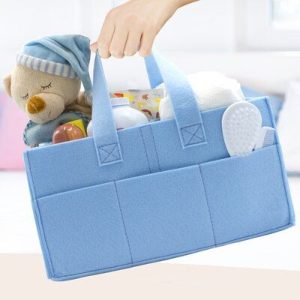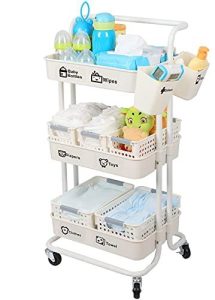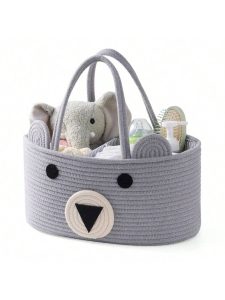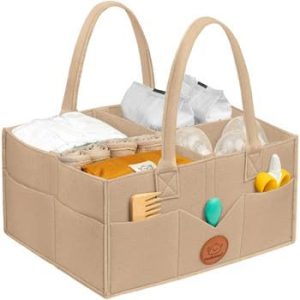Disposable diapers are a convenient and popular choice for parents. But what exactly goes into these little packages that keep your baby comfortable and dry? Let’s delve into the components that make up a disposable diaper.
Breaking Down the Layers
Disposable diapers are not one-size-fits-all. However, most share a similar core construction with different materials for various purposes. Here’s a breakdown of the typical layers:
Topsheet:
This soft, cloth-like material directly touches your baby’s skin. It’s usually made from non-woven materials like polypropylene or polyethylene fibers. These materials are gentle and allow liquids to pass through quickly.
Absorbent Core:
This is the thickest layer and plays a vital role in trapping wetness. It’s typically made from a combination of superabsorbent polymers (SAPs) and fluff pulp. SAPs are tiny, absorbent crystals that can hold many times their weight in liquid. Fluff pulp helps distribute the wetness throughout the core.
Backsheet:
This waterproof layer prevents leaks and keeps moisture away from your baby’s clothes and bedding. It’s often made from a plastic-like material such as polyethylene film.
Fastening System:
Reusable straps or adhesive tapes allow for a secure and adjustable fit. These are usually made from plastic materials or fasteners.
Additional Components: Some diapers may also include features like elastics around the legs for a snug fit, wetness indicators, or lotions to soothe your baby’s skin.
Understanding the Materials
Let’s explore some of the key materials used in disposable diapers:
Non-woven Fabrics: These gentle materials used in the topsheet and other parts of the diaper are created by bonding fibers together. They provide a soft and comfortable feel against your baby’s skin.
Superabsorbent Polymers (SAPs): These are tiny, absorbent crystals that can hold many times their weight in liquid. They are a key component in trapping wetness and preventing leaks.
Fluff Pulp: This absorbent material made from wood pulp helps distribute liquid throughout the diaper core and keeps it from feeling saturated.
Plastics: Polyethylene and polypropylene are commonly used plastics in diapers. They provide waterproofing for the backsheet and other components.
Transparency and Innovation: Diaper manufacturers are constantly working to improve their products. Look for brands that strive for transparency about the materials they use and are committed to innovation in sustainable materials.
Choosing the Right Diaper for Your Baby
With so many options available, choosing the right diaper for your baby can feel overwhelming. Here are some factors to consider:
Absorbency: Consider your baby’s age, wetting habits, and how long you need the diaper to last between changes.
Sensitivity: If your baby has sensitive skin, look for diapers made with hypoallergenic materials and free from fragrances or lotions.
Fit: A snug but comfortable fit is essential to prevent leaks. Look for adjustable straps or tabs for a good fit.
Sustainability: Some diaper brands offer options made with recycled materials or plant-based components.
Remember: Every baby is different, and what works for one baby might not work for another. Experiment with different brands and features to find the diaper that best suits your baby’s needs and your preferences.
Disposable diapers are a convenient and effective way to keep your baby clean and comfortable. Understanding the different components that make up a diaper can help you make informed choices when selecting the best option for your little one. Look for features that prioritize comfort, absorbency, and potentially, eco-friendly materials.

Features for Convenience and Performance
Disposable diaper manufacturers are constantly innovating to improve their products. Here are some features you might find:
Wetness Indicators: Lines or symbols that change color when the diaper is wet, helping you know when it’s time for a change.
Leak Guards: Extra padding around the legs to help prevent leaks.
Breathable Materials: Some diapers are designed to allow airflow, helping to keep your baby’s skin dry and comfortable.
Stretchy Waistbands: Provide a snug and comfortable fit that moves with your baby.
Resealable Tabs: Allow for easy diaper changes and secure disposal.
Remember: Features can vary between brands and diaper types. Consider your baby’s needs and preferences when choosing a diaper.
Benefits of Disposable Diapers
Disposable diapers offer several benefits for parents and caregivers:
Convenience: Disposable diapers are easy to use and dispose of, saving time and simplifying diaper changes.
Leak Protection: Modern disposable diapers are highly absorbent and effective at preventing leaks, keeping your baby dry and comfortable.
Hygiene: Disposable diapers help promote hygiene by containing waste and keeping it away from your baby’s skin.
Travel Friendly: Disposable diapers are compact and portable, making them a convenient choice for travel and outings.
Remember: Disposable diapers are a single-use product and generate waste. Consider your lifestyle and environmental impact when choosing diapering options.
Environmental Considerations
Disposable diapers are a popular choice, but they also contribute to landfill waste. Biodegradable materials and diaper recycling programs are being explored, but these options are not yet widely available.
Environmental Impact: The materials and manufacturing process used in disposable diapers can have an impact on the environment.
Alternatives: Cloth diapers and diaper services are reusable options that can be more eco-friendly.
Choosing the right diaper involves weighing convenience, performance, and environmental impact. Consider your baby’s needs, your lifestyle, and what’s important to you when making your decision.
Responsible Disposal of Disposable Diapers
Disposable diapers are a convenient option for keeping your baby clean and comfortable. However, proper disposal is crucial to minimize environmental impact and prevent sanitation issues.
Waste Receptacles: Always dispose of dirty diapers in a designated diaper pail with a lid. This helps contain odors and prevents pests from accessing the waste.
Liners: Consider using liners in your diaper pail for easier cleaning and disposal. Choose liners that are compatible with your local waste collection guidelines.
Waste Bags: Double bagging soiled diapers in regular plastic bags before placing them in the outdoor trash bin provides extra leak protection.
Local Regulations: Check with your local waste disposal service for specific guidelines on disposing of disposable diapers. Some communities might have restrictions or recommendations.
Remember: Proper hygiene and responsible disposal practices are essential when using disposable diapers.

Conclusion
Disposable diapers offer convenience and effectiveness in keeping your baby clean and dry. Understanding the components, features, benefits, and responsible disposal practices can empower you to make informed choices for your baby’s diapering needs.








